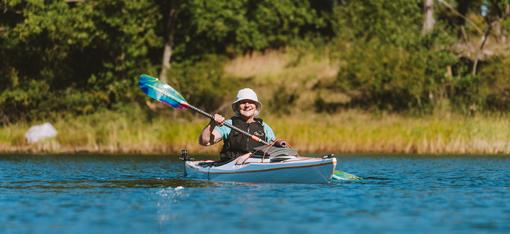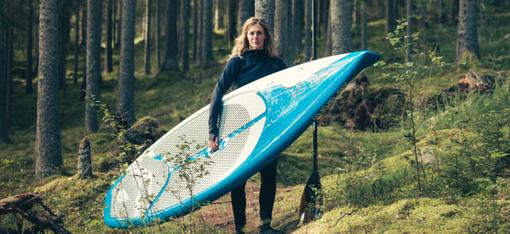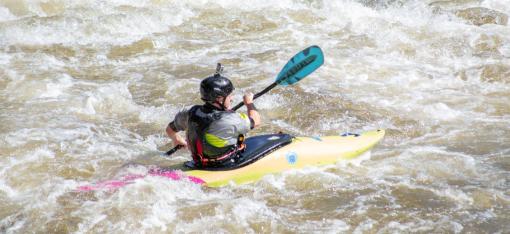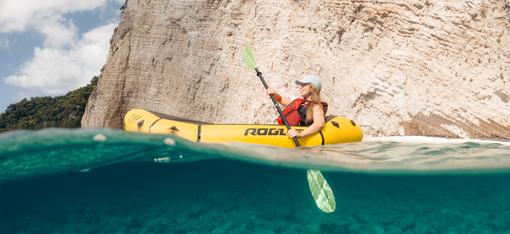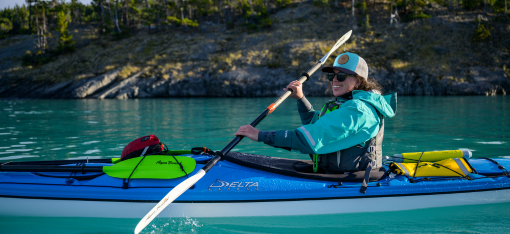What You Need to Know to Kayak in Rough Water
5-minute read + 13-minute video
Kayaking in rough water isn’t for everyone. It’s challenging, can be intimidating and can be dangerous. If you want to paddle rough water, here are a few things you’ll need to know…

Aqua Bound Ambassador Ken Whiting is an experienced ocean kayaker who is used to rough kayaking conditions.
The 13-minute video below features a clip from Ken’s five-day kayak trip on Lake Superior. Superior is big enough that when the wind blows strongly, it feels more like an ocean. While the big lake can be perfectly calm at times, it’s not uncommon to see 2-5 foot waves and higher, including cross waves bouncing back from the shoreline.
Watch the video below to get his tips on rough water kayaking or keep reading:
You Must Have the Right Gear
Having the right gear is extremely important for safe kayaking in rough water, starting with the right type of kayak.
Don’t venture out on rough water (or even potentially rough, as conditions can change quickly) without a touring or sea kayak. Here’s why:
- Touring and sea kayaks are designed to be used with a skirt. The kayak skirt keeps splash from waves out of the cockpit and makes a kayak roll possible in case of a capsize.
- These types of kayaks have watertight bulkheads that stay filled with air rather than water in case of a capsize. This key safety feature means the kayak, if flipped, will sit higher in the water and allow for easier rescue or towing. Once back inside the righted boat, it’s easy to remove the water in the cockpit with a handheld bilge pump.
- Touring and sea kayaks are designed for higher performance with thigh hooks, hip pads and a backband—accessories that help you control the boat much easier in rough water.
Other important gear for rough water conditions is a reliable and durable paddle, a properly-fitted PFD and apparel that will keep you safe in immersion. For example, if you’re kayaking in water that’s cold enough to induce hypothermia quickly, you must wear a wetsuit at minimum and preferably a dry suit.
You Must Have Expert Rescue Skills
Having the right skills is another must-have for safe rough water paddling. Mastering your paddle strokes is a given so you’re confident you can control your boat.

You also must know and have practiced rescue skills in rough water. If you like to paddle solo, then you need to be very good at self-rescue. If you prefer to paddle with others, be comfortable and confident in aiding rescue for others through training and lots of practice in the same rough water conditions where you expect to kayak.
It Helps to Have a Kayak Roll
While not absolutely necessary, in Ken’s opinion, it’s so much easier to be able to roll your kayak upright after a flip than to have to wet exit and climb back in.
He highly recommends you learn and practice a roll until it becomes easy. Having that skill under your belt adds to your confidence and enjoyment, especially in rough conditions.
A great time to learn kayak rolling is during the winter in pool sessions. Look in your area for paddleshops and other ACA-certified organizations or individuals who offer courses at a local pool. This controlled, often one-on-one environment is the ideal place to learn.
Then you can practice in the “real world” with paddling friends or more instruction so you’re proficient in many different water environments and conditions.

You Need to Be in Decent Shape
You don’t need to be a world-class athlete, but you do need to be decently in shape if you want to tackle rough water in your kayak.
Ken says, “When you’re fighting wind and battling waves, you do need some strength. It’s not just technique…and you really don’t have a choice when you’re in those situations. You have to be able to keep plugging away until you can get somewhere sheltered.”
Being fit—both cardio and strength—will vastly improve your time on the water in any kayaking conditions, especially in rough water.
You Need to Know When Safety Demands You Stay Off the Water
Sometimes the water is too rough even for the skills of experienced paddlers. Recognize when the wind speed and wave size are beyond your comfort level and choose to stay on shore. You’ll live to paddle another day.
This is especially key for anyone kayaking solo on a big water trip like this (or any trip, really). If help isn’t at hand, it’s better to stay off the water until conditions calm down.
Take a Rough Water Paddling Course
A great way to gain the experience and confidence you need to kayak in rough water is to take a course from a certified instructor.
Ken says, “In a course like that, you’re going to learn about the safety equipment and how to use it. The equipment you need depends on where you’re going to be paddling. You do need to invest time into gaining knowledge and gaining the hard skills to be able to deal with whatever Mother Nature throws at you.”
The more you know, the safer you’ll be and the more fun you’ll have.

Aqua Bound Ambassador Ken Whiting on Lake Superior
Take an Introductory Whitewater Course
Even better, says Ken, is to take an introductory whitewater kayaking course.
“It’s amazing what you’ll learn about edge control and water dynamics from whitewater kayaking and how much of that applies to rough water paddling,” Ken says. “It provides an incredible foundation and you might just find that you've found another cool new hobby.”
Whitewater kayaking places a heavy emphasis on control and safety that easily crosses over to a rough water (though current-less) environment.
All photos courtesy of Ken Whiting and Go Paddle.
What paddling questions can our friendly Customer Service team help you with? Contact us at 715-755-3405 or sales@aquabound.com, or choose our online chat option.
More for you...

